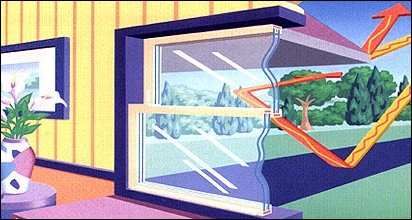


 
 
 
 
 
 
 
 
 
 

Site Designed by:

|
|


Blocking heat loss in winter
All objects emit energy as some form of radiation. Heat from a furnace or a person is "long-wave" radiation. Light from the
sun generates "short-wave" radiation.
During the winter, you want a window that reflects long-wave radiation from your home's furnace back inside. It should also
let the sun's short-wave radiation into your home. The short-wave energy is then absorbed by objects, even people, and is
radiated from them as long-wave heat.
A well designed window takes full advantage of the sun's energy, keeping you and your home warm all winter long.

Keeping cool in the summer
A well-designed glass system will also keep you cool in the summer. Most systems are designed for winter weather, and do not
perform well in the summer. CertainTeed's Thermaflect system is balanced -- so you get the best performance when it's hot or
cold. Thermaflect significantly blocks infrared energy, the energy from the direct rays of the sun in the summer. In fact,
it blocks it three times better than ordinary Low "E" systems.

Saving money with Thermaflect
Whether your winters are snowy and long, or the sun rides high every day, Thermaflect's balanced performance can help reduce
the cost of keeping your home comfortable.
Performance terms
Here is a glossary of some important terms associated with your window's thermal performance:
Low E: Low-emissivity glass is coated with a microscopically thin metallic layer that enables visible light to pass
through, while blocking ultraviolet and infrared solar energy and reflecting away long-wave roomside heat energy. Different
types of Low "E" coatings offer varying levels of performance for each of these tasks.
U-value: The rate of heat flow through a glazing system; the lower the value, the better the insulating quality.
U-value can be compared to R-value by dividing 1 by the U-value. (Thus, a U-value of 0.5 equals an R-value of 2.)
Daylight transmittance: Measures the amount of visible light that is transmitted through the glass.
UV block: Measures the amount of damaging ultraviolet light that is blocked from being transmitted through the
glass.
Solar heat gain coefficient: The amount of direct solar radiation that enters through the glass into the home as heat.
The smaller the number, the better the glazing is at preventing solar heat gain.
Factory Direct
1213 South Auburn Ave Colfax, Ca 95713
530.346.6453 Fax 530.346.7854
1.800.649.7499 sales@vinyl-aluminum.com
C.L. # 625006
|
|




